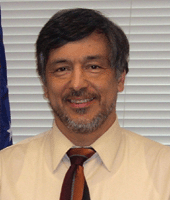A secure SOA for DOD


Connecting state and local government leaders
2008 GCN Technology Leadership Award winner Vera sets the requirements for protecting enterprise services.

Carlos Vera is the Net-Centric Enterprise Services deputy program manager and a 2008 GCN Technology Leadership Award winner.
Submitted photo
In some ways, the Defense Department's task of keeping the
country secure starts with keeping its own information technology
systems secure. The job is never easy, and it gets more complicated
with the shift from a systems-based approach to a service-oriented
architecture. So as DOD implemented its SOA-based Net-Centric
Enterprise Services (NCES) platform during the past year, its
managers had to find a new way to secure services.
'Initially, we thought that taking a centralized approach
to enterprise security was best,' said Carlos Vera, deputy
program manager at NCES, which is under the purview of the Defense
Information Systems Agency. 'What we have learned is that is
the wrong model. We can't do everything at the enterprise
level.'
Instead, NCES migrated to a system that established a security
framework and protocol for how services should securely talk to one
another, specifying the requirements while holding service
providers responsible for their own policy enforcement.
For example, he is working to ensure that the services satisfy
Federal Information Processing Standard 140-2 cryptographic models
for network transmissions and data at rest, particularly on the
Non-secure IP Router Network. But he doesn't specify how
providers should do it.
Vera 'has pioneered a new way of addressing information
assurance' at DOD, said DISA computer scientist Tom
Hazelwood. 'His determination and efforts have defined a new
path for delivering capabilities to the warfighter.'
Vera began his defense IT career performing software engineering
research on the Ada language and distributed real-time systems for
the Army Communications and Electronics Command at Fort Malmouth,
N.J. After four years there, he returned to San Antonio with his
wife and four children to provide postdeployment software support
for the Air Force's Modular Automatic Test Equipment system
and later led the software engineering process group at Kelly Air
Force Base. He spent nearly a decade working on information
assurance as a division chief of the Air Force's cryptologic
systems group at Lackland Air Force Base, Texas, where he oversaw
the issuance of 1 million Common Access Cards.
'We also did a lot of research for the intelligence
community focusing on information assurance architectures as well
as how we go about helping the community to identify
vulnerabilities, characterize them and ultimately say what the
semantics are for the vulnerabilities,' Vera said. 'We
started the CVE initiative ' common vulnerabilities and
exposure ' that has spread out as a standard among all the
commercial vendors as a vulnerability identification.'
From Lackland, he came to DISA as chief information assurance
engineer, which included securing NCES.
'One of the fundamental issues is: What does it to mean to
make an enterprise service available to the community?' Vera
said. 'You have all these ports and services that are being
driven across the network, but are they secure services, and have
they been approved? We need to make sure we are all following the
same set of ground rules, and the same documentation is being
generated.'
That goal is complicated by the structure of NCES. Different
sources provide the four product lines: the SOA foundation,
collaboration, content discovery and delivery, and portal.
The Army's Defense Knowledge Online provides
managed-services user access. Users can collaborate via IBM's
Sametime or Carahsoft's Adobe Connect and Jabber solution.
For content discovery and delivery, ISYS search software provides
Google search appliances through Intelink, and Akamai provides
forward-hosting of cached Web data. Computer Sciences Corp.
provides messaging, discovery, monitoring and security of services.
The services are hosted at Defense Enterprise Computing Centers or
commercial facilities. DISA establishes security and service
parameters but lets service providers determine the best way to
meet those requirements.
'We need to make sure that the services being deployed are
secure and that they will be able to satisfy our
requirements,' he said. 'Once we have determined that,
it is performance-based.'
NEXT STORY: William Jackson | What leadership can do




